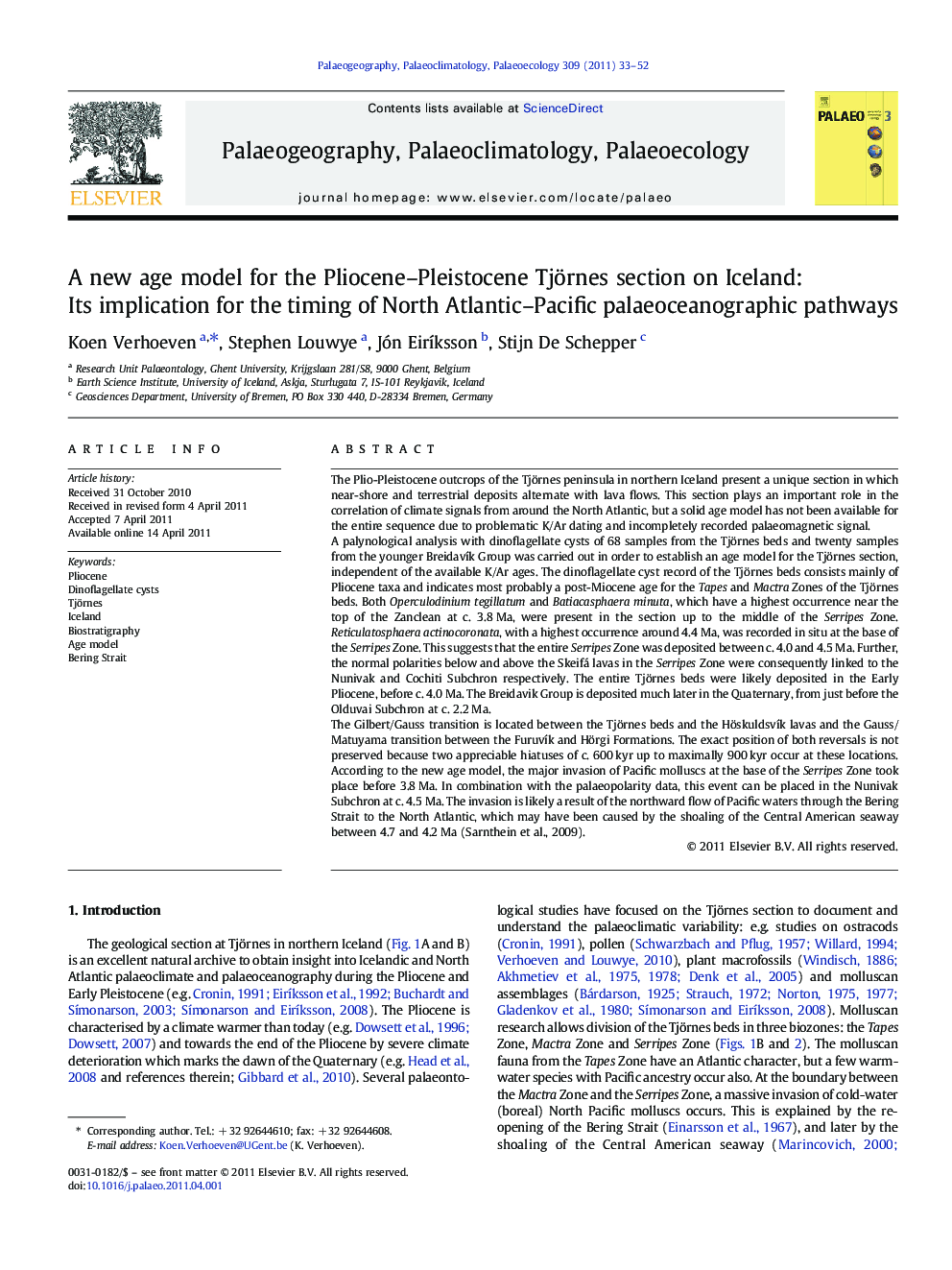| کد مقاله | کد نشریه | سال انتشار | مقاله انگلیسی | نسخه تمام متن |
|---|---|---|---|---|
| 4467171 | 1622250 | 2011 | 20 صفحه PDF | دانلود رایگان |

The Plio-Pleistocene outcrops of the Tjörnes peninsula in northern Iceland present a unique section in which near-shore and terrestrial deposits alternate with lava flows. This section plays an important role in the correlation of climate signals from around the North Atlantic, but a solid age model has not been available for the entire sequence due to problematic K/Ar dating and incompletely recorded palaeomagnetic signal.A palynological analysis with dinoflagellate cysts of 68 samples from the Tjörnes beds and twenty samples from the younger Breidavík Group was carried out in order to establish an age model for the Tjörnes section, independent of the available K/Ar ages. The dinoflagellate cyst record of the Tjörnes beds consists mainly of Pliocene taxa and indicates most probably a post-Miocene age for the Tapes and Mactra Zones of the Tjörnes beds. Both Operculodinium tegillatum and Batiacasphaera minuta, which have a highest occurrence near the top of the Zanclean at c. 3.8 Ma, were present in the section up to the middle of the Serripes Zone. Reticulatosphaera actinocoronata, with a highest occurrence around 4.4 Ma, was recorded in situ at the base of the Serripes Zone. This suggests that the entire Serripes Zone was deposited between c. 4.0 and 4.5 Ma. Further, the normal polarities below and above the Skeifá lavas in the Serripes Zone were consequently linked to the Nunivak and Cochiti Subchron respectively. The entire Tjörnes beds were likely deposited in the Early Pliocene, before c. 4.0 Ma. The Breidavik Group is deposited much later in the Quaternary, from just before the Olduvai Subchron at c. 2.2 Ma.The Gilbert/Gauss transition is located between the Tjörnes beds and the Höskuldsvík lavas and the Gauss/Matuyama transition between the Furuvík and Hörgi Formations. The exact position of both reversals is not preserved because two appreciable hiatuses of c. 600 kyr up to maximally 900 kyr occur at these locations. According to the new age model, the major invasion of Pacific molluscs at the base of the Serripes Zone took place before 3.8 Ma. In combination with the palaeopolarity data, this event can be placed in the Nunivak Subchron at c. 4.5 Ma. The invasion is likely a result of the northward flow of Pacific waters through the Bering Strait to the North Atlantic, which may have been caused by the shoaling of the Central American seaway between 4.7 and 4.2 Ma (Sarnthein et al., 2009).
Research Highlights
► Organic-walled dinoflagellate cysts are recorded from almost all sediments of the Tjörnes section in northern Iceland.
► The biostratigraphical analysis indicates an Early Pliocene age for the Tjörnes beds.
► A re-correlation of the palaeomagnetic polarity data with the new biostratigraphical data allowed to propose a new age model.
► The invasion of Pacific molluscs at the Mactra/Serripes boundary could be linked to the upper Nunivak Subchron around c. 4.5 Ma.
► It is suggested that this invasion is related to the shoaling of the Central American seaway.
Journal: Palaeogeography, Palaeoclimatology, Palaeoecology - Volume 309, Issues 1–2, 15 August 2011, Pages 33–52